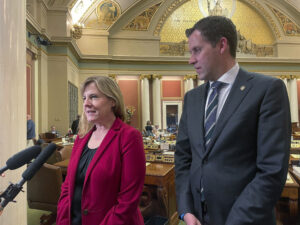Jeff Madrick on ‘High Wire,’ Peter Gosselin’s Look at the Economic Meltdown
A star reporter for the Los Angeles Times has written a clear, even elegant anatomy of an economy that is much worse than you probably think.
It would be a pity if Peter Gosselin’s new book, “High Wire: The Precarious Financial Lives of American Families,” gets lost in the current turmoil over subprime mortgages and deepening recession. He has done the most convincing job I’ve seen in capturing the failures of America to deal with a changing, complex and far less generous economy than it has known in the past. That economy, despite cyclically painful periods, was so generous compared to the rest of the world over its 200-year history in terms of the rate at which it expanded the typical American’s standard of living that the country’s national character was formed by it. The resulting tendency in America, though thankfully violated from time to time, is decidedly toward a laissez faire philosophy of government.
But that national character is now being tested in a less friendly economic environment. Are America’s reflexes, honed over a couple of centuries, up to the task? It is not clear.
Peter Gosselin’s admirable objective is to show how many people of all income levels are now insecure and afraid in an economy that Americans are constantly told, by Republicans and Democrats alike, has long been back on track. At least, that was the conventional wisdom until a year or so ago, when the current hydra-headed crisis emerged. But, in truth, the American economy has not been on track for a generation now. Even the Clinton interlude was, as we now know, prompted by intense and unsustainable financial and housing speculation.
The main theme of Gosselin, a veteran reporter for the Los Angeles Times, is the rise of deep-seated financial, health and material risk. He gathers the many pieces of the new economic America together quite beautifully, even elegantly, and brings them alive with interesting and not the usually predictable individual examples. I learned many things in this book, and I’ve been covering this territory for a long time.
Take pension and health-care coverage. Most of us who read about these matters know about, and too many of us have already lived through, the growing failure of America’s pension and health-care system. Americans depend on having a good job for having a good pension. Now pensions are being frozen by major companies like IBM, many industries from autos to airlines are on a downward slide and their pension funds won’t pay off, and the Enrons of the world caused many to lose hundreds of thousands of dollars of retirement savings through fraud.
Less well known, half of Americans work for a company today that offers no retirement plan at all.
And then there are the 401(k)s. Gosselin says the major shift in America toward a riskier society regards retirement. Three out of five employees who are fortunate enough to have a private retirement plan now don’t have a pension at all but rather a defined contribution plan like a 401(k) to which they must contribute, and then manage the money. Many and probably most will save too little and invest unwisely. As for health-care plans, co-pays are going up, employees are losing coverage and the health plans don’t pay off as they promise, the latter a scandal that needs far more airing.
As for health care, few can remotely afford a policy that is not financed by the job. And more than 15 percent of Americans have no health insurance, anyway. Many of those work or are in a family with a worker. The deaths caused by lack of insurance should startle the nation.
But what makes Gosselin so interesting is that he digs further for the pertinent government failures. For example, the Employee Retirement Security Act (ERISA), passed in 1974 originally to protect workers, now, as he writes, protects big companies. The reason is that ERISA prevents companies from being sued by employees. In the current age, “[ERISA] has become a crucial vehicle for shifting economic dangers that our employers once helped us manage onto our backs.” And then Gosselin gives a few poignant examples of the injured parties. Like the woman, Debra Potter, who was denied medical coverage though she had multiple sclerosis. (ERISA’s reach has been expanded to include health-care coverage.) She couldn’t sue to get her benefits and got far less than needed. I for one was not fully aware of this outrage.
A former insurance consultant told me recently that some employees are paid at insurance companies according to how many claims they can deny. I was shocked. Naive me, and after all these years. Of course, that is how the companies operate. Create incentives to maximize profits.
Gosselin’s central claim is based on some research he did to show that the proportion of American families whose incomes are likely to fall substantially has risen sharply since the 1970s. I can’t vouch for the methodology, but it seems correct on a quick reading (and he defends it persuasively against other views in a section on methods). More precisely, the probability that income for a family will drop by 50 percent in any two-year period has risen from one in 20 families to one in 10. One in 10 is pretty darn high, and that’s in any two-year period. Over time, more will fall into the category. What’s more, there is much less chance of making a big comeback and rising to one’s old income level than there was 30 years ago.
Gosselin computes, using another methodology, that incomes in general fluctuate more — by as much as 26 percent on average for the typical family as opposed to 17 percent years ago. When families depend on two incomes, as many do today, such wide fluctuations make sense. Family incomes are up if modestly over 30 years, but mostly because the spouse now goes to work. If the spouse leaves the work force for whatever reason, the income falls sharply in percentage terms. That wouldn’t be bad if that income were just frosting on the cake, but spousal income is often critical to well-being now because wages have stagnated for so many. Gosselin even makes a chapter on America’s poor sound original. The poor are not different — they are like you and me, he says, simply trying to make ends meet and get a life, especially for their kids, and even hold in their hearts a hope for the American dream. He finds conservative claims that we have conquered poverty nonsense. Gosselin is a little too optimistic that “deprivation” has been eliminated in America, as some conservatives like to say. How poorly those in poverty eat we now know. Diabetes is up, not because the poor are literally hungry — some in America do go hungry, by the way — but partly and maybe largely because bad food is almost always so much cheaper and readily available than nutritious food.
Gosselin, however, puts his finger on it. Poverty is not about black-and-white deprivations in the contemporary world. The poor in America live in total chaos — in his words, “… — pay cuts and eviction notices, car troubles and medical crises, hirings and firings — that keeps reversing their families’ advances, rattling their finances, nudging them toward the economic brink.” Some have the audacity to say the poor can use their credit cards to bail themselves out of disaster. Yes, at 18 percent interest. Bring on the Mob! What do the poor borrow for? A good restaurant meal? A pair of impossibly expensive sneakers? Maybe, once in a while. But Gosselin looks into a case or two: $170 to fix the steering on the car, a $300 cash advance for the rent, another $1,000 to bring a wife to the U.S. from Central America.
On education, Gosselin tells us that a college degree doesn’t guarantee a good job but often lots of debt. On housing, he sniffed out the subprime dangers early. Regarding health coverage, he notes the usual problems of a health-care system dependent on the job: reduced coverage, higher co-pays. But he delves into the even more alarming scandal of policy cancellations and rescissions by supposedly respectable companies, a stunning and growing national disgrace that doesn’t receive enough attention.
Gosselin doesn’t get everything, however. There is the shocking level of child poverty in America, higher by most measures than anywhere else in the rich world. There is highly unequal quality of public education.
But, most important, there is simply the long stagnation in earnings, most obvious when we isolate males from females. Gosselin buys too easily into the notion that the American economy has, based on the conventional data like the unemployment rate and the growth rate, done well for a generation and that it is essentially financial security that is the issue.
Not exactly so. To be precise, the 30-something median male — in the middle of the distribution — makes less after inflation today than did the 30-something male in the 1970s. As some perceptive commentators put it, the typical male today makes less than his father did 30 years ago.
This needed more attention in an otherwise excellent book. In other words, typical men have made no progress compared with typical men a generation ago. This experience violates the true American dream, not the one about how we can all get rich, but the one about how, if we work hard, most of us will do better over time than the previous generation. We can’t all rise higher on the pyramid, but the whole pyramid can rise. In fact, that is what happened in the U.S. since the beginning. That is what made the nation special and its people optimistic. But now it no longer does.
Meanwhile, women’s wages are up, and that’s what has mostly kept family income rising. But there is still an enormous gap between what men and women earn, far more than in some European nations, for example. In Sweden, men and women make about the same. Labor market discrimination? You bet.
At least men haven’t fallen much behind in America, some will answer. Well, high-school-educated males have fallen behind by a lot. College-educated males have seen median wages stagnate for 30-year stretches and longer. Here’s some of my own data, done with the estimable researcher Nikos Papanikolaou.
Median Males: High School (12th-grade diploma)
| Age 25-34 | Age 35-44 | Age 45-54 | |
| 1979 | $36,865 | $42,358 | $44,102 |
| 2005 | $30,000 | $37,550 | $39,000 |
Note below that even typical men with a college education have seen no increase in earnings for 20- and 25-year stretches since 1969.
Median males: College (Four years / degree)
| age 25-34 | age 35-44 | age 45-54 | |
| 1969 | $45,634 | $54,760 | $52,479 |
| 1979 | $40,489 | $54,816 | $64,783 |
| 1989 | $44,925 | $54,731 | $66,105 |
| 2000 | $45,342 | $58,945 | $63,480 |
| 2005 | $47,000 | $63,000 | $64,000 |
Data: Jeff Madrick and Nikos Papanikolaou, Schwartz Center for Economic Policy Analysis, The New School.
But more to the point, inflation-adjusted income, even if it rises slightly, does not mean that people are actually keeping up. The costs of education, health care, drugs and public investment have gone up much faster than incomes. So people can buy clothes, food or electronics more easily, but they can’t buy health care, or they have to move into an expensive house to get a good k-12 education for the kids. Or they can’t as easily afford their commuting costs. A subway ride in New York in the 1970s cost 35 cents; now it’s $2. That adds $50 a month to the commuting bill. This is why Barack Obama is right when he talks about bitterness and anger, and why claims that the political attitudes are only about culture shifts is wrong.
Now the experience of the 2000s has brought the message home. Wages haven’t gone up at all in the 2000s, despite record profits and decent productivity growth. Family incomes are down. These are unprecedented in the modern economy.
And all this follows a generation of rising insecurity, uncertainty, unrewarded effort and for many a treadmill of growing despair, cynicism and occasional chaos that this author describes so clearly, even elegantly. Gosselin’s gotten the new American condition better than anyone else I’ve read.
Jeff Madrick is editor of Challenge Magazine and senior fellow at the Schwartz Center for Economic Policy Analysis, The New School. A book of lectures, “The Case for Big Government,” will be out in June, from Princeton. He is also at work on a history of the U.S. economy since 1970, to be published by Alfred A. Knopf.
Your support matters…Independent journalism is under threat and overshadowed by heavily funded mainstream media.
You can help level the playing field. Become a member.
Your tax-deductible contribution keeps us digging beneath the headlines to give you thought-provoking, investigative reporting and analysis that unearths what's really happening- without compromise.
Give today to support our courageous, independent journalists.










You need to be a supporter to comment.
There are currently no responses to this article.
Be the first to respond.